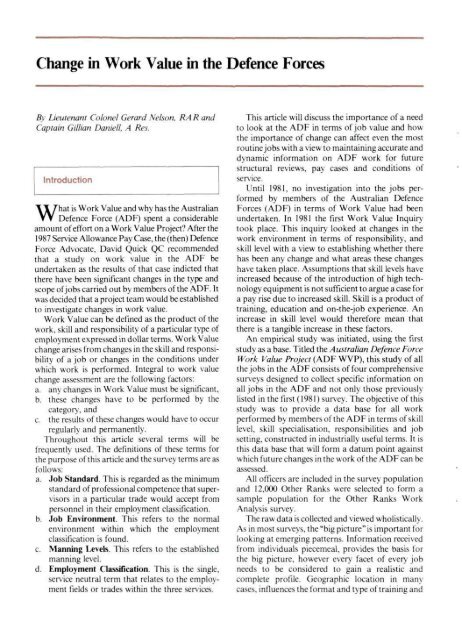ISSUE 91 : Nov/Dec - 1991 - Australian Defence Force Journal
ISSUE 91 : Nov/Dec - 1991 - Australian Defence Force Journal
ISSUE 91 : Nov/Dec - 1991 - Australian Defence Force Journal
Create successful ePaper yourself
Turn your PDF publications into a flip-book with our unique Google optimized e-Paper software.
Change in Work Value in the <strong>Defence</strong> <strong>Force</strong>s<br />
By Lieutenant Colonel Gerard Nelson, RA R and<br />
Captain Gillian Daniell, A Res.<br />
Introduction<br />
What is Work Value and why has the <strong>Australian</strong><br />
<strong>Defence</strong> <strong>Force</strong> (ADF) spent a considerable<br />
amount of effort on a Work Value Project? After the<br />
1987 Service Allowance Pay Case, the (then) <strong>Defence</strong><br />
<strong>Force</strong> Advocate, David Quick QC recommended<br />
that a study on work value in the ADF be<br />
undertaken as the results of that case indicted that<br />
there have been significant changes in the type and<br />
scope of jobs carried out by members of the ADF. It<br />
was decided that a project team would be established<br />
to investigate changes in work value.<br />
Work Value can be defined as the product of the<br />
work, skill and responsibility of a particular type of<br />
employment expressed in dollar terms. Work Value<br />
change arises from changes in the skill and responsibility<br />
of a job or changes in the conditions under<br />
which work is performed. Integral to work value<br />
change assessment are the following factors:<br />
a. any changes in Work Value must be significant,<br />
b. these changes have to be performed by the<br />
category, and<br />
c. the results of these changes would have to occur<br />
regularly and permanently.<br />
Throughout this article several terms will be<br />
frequently used. The definitions of these terms for<br />
the purpose of this article and the survey terms are as<br />
follows:<br />
a. Job Standard. This is regarded as the minimum<br />
standard of professional competence that supervisors<br />
in a particular trade would accept from<br />
personnel in their employment classification.<br />
b. Job Environment. This refers to the normal<br />
environment within which the employment<br />
classification is found.<br />
c. Manning Levels. This refers to the established<br />
manning level.<br />
d. Employment Classification. This is the single,<br />
service neutral term that relates to the employment<br />
fields or trades within the three services.<br />
This article will discuss the importance of a need<br />
to look at the ADF in terms of job value and how<br />
the importance of change can affect even the most<br />
routine jobs with a view to maintaining accurate and<br />
dynamic information on ADF work for future<br />
structural reviews, pay cases and conditions of<br />
service.<br />
Until 1981, no investigation into the jobs performed<br />
by members of the <strong>Australian</strong> <strong>Defence</strong><br />
<strong>Force</strong>s (ADF) in terms of Work Value had been<br />
undertaken. In 1981 the first Work Value Inquiry<br />
took place. This inquiry looked at changes in the<br />
work environment in terms of responsibility, and<br />
skill level with a view to establishing whether there<br />
has been any change and what areas these changes<br />
have taken place. Assumptions that skill levels have<br />
increased because of the introduction of high technology<br />
equipment is not sufficient to argue a case for<br />
a pay rise due to increased skill. Skill is a product of<br />
training, education and on-the-job experience. An<br />
increase in skill level would therefore mean that<br />
there is a tangible increase in these factors.<br />
An empirical study was initiated, using the first<br />
study as a base. Titled the <strong>Australian</strong> <strong>Defence</strong> <strong>Force</strong><br />
Work Value Project (ADF WVP), this study of all<br />
the jobs in the ADF consists of four comprehensive<br />
surveys designed to collect specific information on<br />
all jobs in the ADF and not only those previously<br />
listed in the first (1981) survey. The objective of this<br />
study was to provide a data base for all work<br />
performed by members of the ADF in terms of skill<br />
level, skill specialisation, responsibilities and job<br />
setting, constructed in industrially useful terms. It is<br />
this data base that will form a datum point against<br />
which future changes in the work of the ADF can be<br />
assessed.<br />
All officers are included in the survey population<br />
and 12,000 Other Ranks were selected to form a<br />
sample population for the Other Ranks Work<br />
Analysis survey.<br />
The raw data is collected and viewed wholistically.<br />
As in most surveys, the "big picture" is important for<br />
looking at emerging patterns. Information received<br />
from individuals piecemeal, provides the basis for<br />
the big picture, however every facet of every job<br />
needs to be considered to gain a realistic and<br />
complete profile. Geographic location in many<br />
cases, influences the format and type of training and

















